2019-2021
2018-2021
Physics of Cold Atomic Systems
current researchers : Janik Schönmeier-Kromer, Fabian Grusdt (LS Schollwöck), Lode Pollet
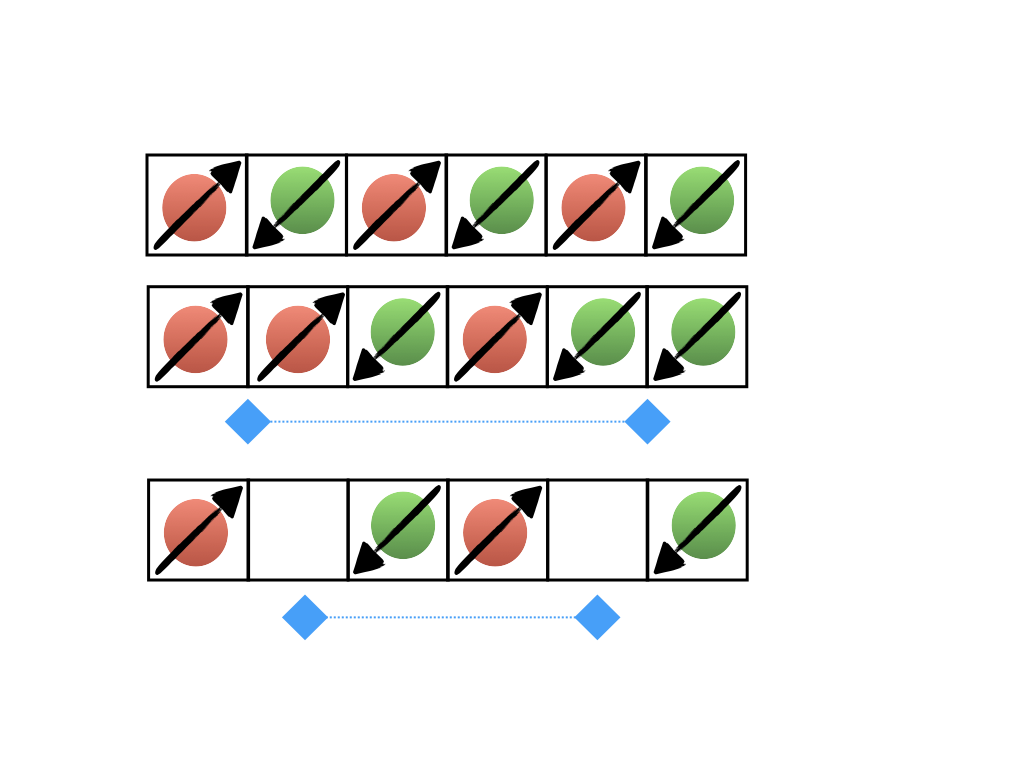 We are interested in the phenomenology of cold atomic systems in a wide variety of settings. (i) We explore the possibilities a microscope offers to the experimental study of cold fermionic samples aiming at identifying novel types of magnetism and superfluidity in Hubbard-like models . (ii) We also study a Bose-Fermi-Mott Hubbard model in one dimensions. (iii) In collaboration with Fabian Grusdt we are currently examining mixed-dimensional t-J models aiming to study stripe formation and with links to lattice gauge theories. The main tools are quantum Monte Carlo simulations, exact diagonalization and the renormalisation group theory of critical phenomena.
We are interested in the phenomenology of cold atomic systems in a wide variety of settings. (i) We explore the possibilities a microscope offers to the experimental study of cold fermionic samples aiming at identifying novel types of magnetism and superfluidity in Hubbard-like models . (ii) We also study a Bose-Fermi-Mott Hubbard model in one dimensions. (iii) In collaboration with Fabian Grusdt we are currently examining mixed-dimensional t-J models aiming to study stripe formation and with links to lattice gauge theories. The main tools are quantum Monte Carlo simulations, exact diagonalization and the renormalisation group theory of critical phenomena.
References:
- Science 353, Iss 6305, p. 1257 (2016)
- Nature 565, 56-60 (2019)
- Phys. Rev. Lett. 125, 256401 (2020)
- Phys. Rev. B 107, 054502 (2023)
Tensorial-Kernel Support Vector machines for automated phase diagram determination
current researchers : Nihal Rao, Ke Liu, Lode Pollet; previous : Jonas Greitemann
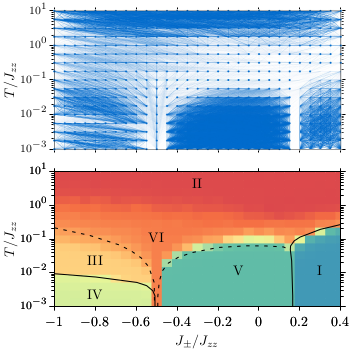 Facial recognition in airports and autonomous driving are two daily life examples of the recent progress in artificial intelligence. But can machines also facilitate the work of a physicist by independently interpreting experiments or simulations? In a series of papers building up complexity, we show that machine learning can successfully unravel the complex phase diagram found in classical Monte Carlo simulation of a highly frustrated magnet, identifying and correctly characterising all of the different phases present, without training or supervision (in collaboration with Ludovic Jaubert, Han Yan, and Nic Shannon). The method used is interpretable, and provides analytic expressions for the order parameters of each of the broken symmetry phases. It also provides analytical expressions of the local constraints that characterize each spin liquid, and underpin their topological properties. This work shows machine learning can mature into a trustworthy tool for exploring exotic phases in many-body systems.
Facial recognition in airports and autonomous driving are two daily life examples of the recent progress in artificial intelligence. But can machines also facilitate the work of a physicist by independently interpreting experiments or simulations? In a series of papers building up complexity, we show that machine learning can successfully unravel the complex phase diagram found in classical Monte Carlo simulation of a highly frustrated magnet, identifying and correctly characterising all of the different phases present, without training or supervision (in collaboration with Ludovic Jaubert, Han Yan, and Nic Shannon). The method used is interpretable, and provides analytic expressions for the order parameters of each of the broken symmetry phases. It also provides analytical expressions of the local constraints that characterize each spin liquid, and underpin their topological properties. This work shows machine learning can mature into a trustworthy tool for exploring exotic phases in many-body systems.
References:
- Phys. Rev. B 99, 060404(R) (2019)
- Phys. Rev. B 99, 104410 (2019)
- Phys. Rev. B 100, 174408 (2019)
Bosonic Cluster Selfenergy Theory for Systems with Magnetic Fields
researchers : Rajah Nutakki, Lode Pollet ; previous : Dario Hügel
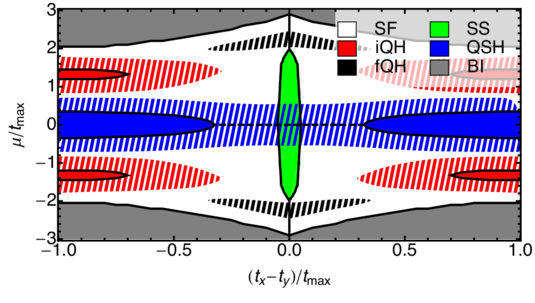 While being the method of choice for many bosonic problems, quantum Monte Carlo simulations suffer from an intractable sign problem in the presence of artificial gauge fields, frustration or real frequencies. This motivates the need for new approximate numerical methods such as bosonic dynamical mean-field theory, bosonic self-energy functional theory, and reciprocal cluster mean-field. In these methods an impurity (cluster) is solved numerically and consequently embedded into the original system. The interplay between topological band structures and strong interactions is currently hotly debated. In the figure we show the phase diagram of the Harper-Hofstadter-Mott model for hardcore bosons and magnetic flux π/2, indicating symmetry broken phases, fractional Chern insulators, and symmetry protected phases, among others.
While being the method of choice for many bosonic problems, quantum Monte Carlo simulations suffer from an intractable sign problem in the presence of artificial gauge fields, frustration or real frequencies. This motivates the need for new approximate numerical methods such as bosonic dynamical mean-field theory, bosonic self-energy functional theory, and reciprocal cluster mean-field. In these methods an impurity (cluster) is solved numerically and consequently embedded into the original system. The interplay between topological band structures and strong interactions is currently hotly debated. In the figure we show the phase diagram of the Harper-Hofstadter-Mott model for hardcore bosons and magnetic flux π/2, indicating symmetry broken phases, fractional Chern insulators, and symmetry protected phases, among others.
References:
- Phys. Rev. B 94, 195119 (2016)
- Phys. Rev. B 96, 054431 (2017)
- New J Phys 20, 043001 (2018)
Disordered Systems and Many-Body Localization
current researchers : Lode Pollet, previous : Stephen Inglis, Tobias Pfeffer
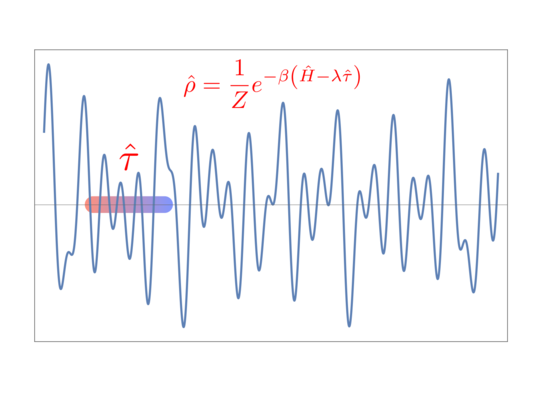 Our group has many years of experience in dealing with the ground state of disordered bosonic systems, featuring an ergodic phase as well as a non-ergodic glassy phase. Such phase diagrams have been obtained by path integral Monte Carlo simulations. The current frontier in this field is whether a generalized transition can also occur at finite energy and non-zero interaction strength. This is an intriguing question implying that there may exist a phase of matter which violates the eigenstate thermalization hypothesis of statistical mechanics and shows other unusual properties: The system would retain knowledge of its initial conditions, have a zero dc conductivity, and feature an area law, among others. A compelling description for this many-body localized phase is in terms of an extensive set of emergent local integrals of motion (see figure). We attempt to get an accurate description of those, and use them consequently in order to study the properties of excited eigenstates. Those are identified as ground states from a related system found by shifting the original action by the found local integrals of motion.
Our group has many years of experience in dealing with the ground state of disordered bosonic systems, featuring an ergodic phase as well as a non-ergodic glassy phase. Such phase diagrams have been obtained by path integral Monte Carlo simulations. The current frontier in this field is whether a generalized transition can also occur at finite energy and non-zero interaction strength. This is an intriguing question implying that there may exist a phase of matter which violates the eigenstate thermalization hypothesis of statistical mechanics and shows other unusual properties: The system would retain knowledge of its initial conditions, have a zero dc conductivity, and feature an area law, among others. A compelling description for this many-body localized phase is in terms of an extensive set of emergent local integrals of motion (see figure). We attempt to get an accurate description of those, and use them consequently in order to study the properties of excited eigenstates. Those are identified as ground states from a related system found by shifting the original action by the found local integrals of motion.
References:
- Phys. Rev. B 93, 094404 (2016)
- Phys. Rev. Lett. 117, 120402 (2016)
- Phys. Rev. B 99, 104514 (2019)
Advances in understanding the convergence of Monte Carlo Methods: Homotopy Analysis Method
current researchers : Lode Pollet, previous : Tobias Pfeffer
Developing first-principles methods for strongly-interacting many-body systems remains an active field of research in theoretical physics. Quantum Monte Carlo algorithms based on the path integral formulation are often the method of choice because of their versatility. However, in the absence of a positive expansion scheme, Monte Carlo algorithms scale exponentially. This is the case for interacting Fermi systems without special symmetry and frustrated spin systems.
An alternative approach to study such systems are semi-analytical 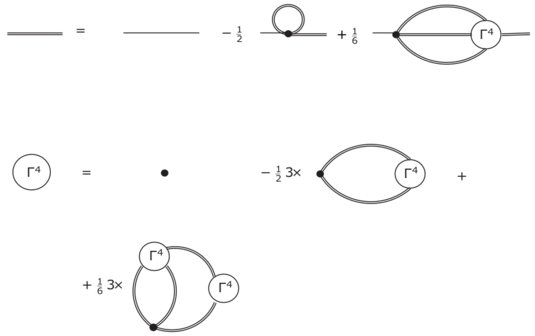 techniques such as resummed perturbation theory or other skeleton approaches. Most notably are Dyson-Schwinger equations and functional renormalization group equations. In our work we combine the Monte Carlo method with such semi-analytical approaches. The key concept used is this work is the expansion in rooted trees and stochastic summation of numerical root finding algorithms which can be used to solve integral equations or even more complicated functional integro-differential equations. The goal of this work is to overcome the main limiting factors of these skeleton approaches by using the Monte Carlo method.
techniques such as resummed perturbation theory or other skeleton approaches. Most notably are Dyson-Schwinger equations and functional renormalization group equations. In our work we combine the Monte Carlo method with such semi-analytical approaches. The key concept used is this work is the expansion in rooted trees and stochastic summation of numerical root finding algorithms which can be used to solve integral equations or even more complicated functional integro-differential equations. The goal of this work is to overcome the main limiting factors of these skeleton approaches by using the Monte Carlo method.
The figure shows the leading terms in the Dyson-Schwinger expansion of the φ4 model.
References:
- New J Phys 19, 043005 (2017)
- Phys. Rev. B 98, 195104 (2018)
Diagrammatic Monte Carlo simulation of the polaron problem
current researchers : Stefan Wittlinger, Tuomas Vanhala, Lode Pollet, previous : Peter Kroiss
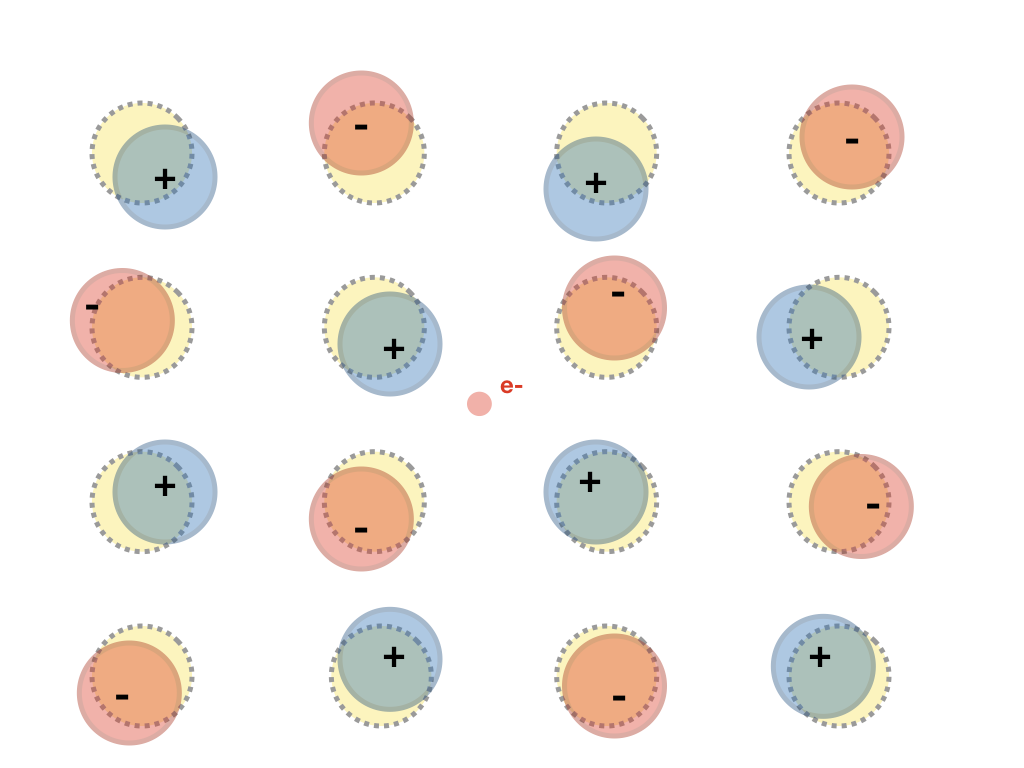 A single electron moving through a crystal interacts with the displaced ions. Landau, later elaborated by Frohlich, showed that the electron behaves as a quasi-particle: the electron drags a phonon cloud witht the property that ?
A single electron moving through a crystal interacts with the displaced ions. Landau, later elaborated by Frohlich, showed that the electron behaves as a quasi-particle: the electron drags a phonon cloud witht the property that ?
is composite object behaves almost as a free particle but with some renormalized parameters such as its mass and residue. Its thermodynamic properties are under good theoretical control, but transport properties such as its mobility remain poorly understood and provide an active field of research (also for different kinds of polarons such as Fermi-polarons). Understanding the mobility is of great importance for eg semiconductors such as the halide perovskites (photovoltaics).
References:
- Phys. Rev. B 90, 104510 (2014)
- Phys. Rev. Lett. 113, 195301 (2014)
- Phys. Rev. B 91, 144507 (2015)
- Phys. Rev. B 94, 075157 (2016)
- SciPost Phys. Lect. Notes 2 (2018)
- Phys. Rev. Lett. 123, 076601 (2019)
a constrained Random Phase Approximation to magic angle twisted bilayer graphene
researchers: Tuomas Vanhala, Lode Pollet
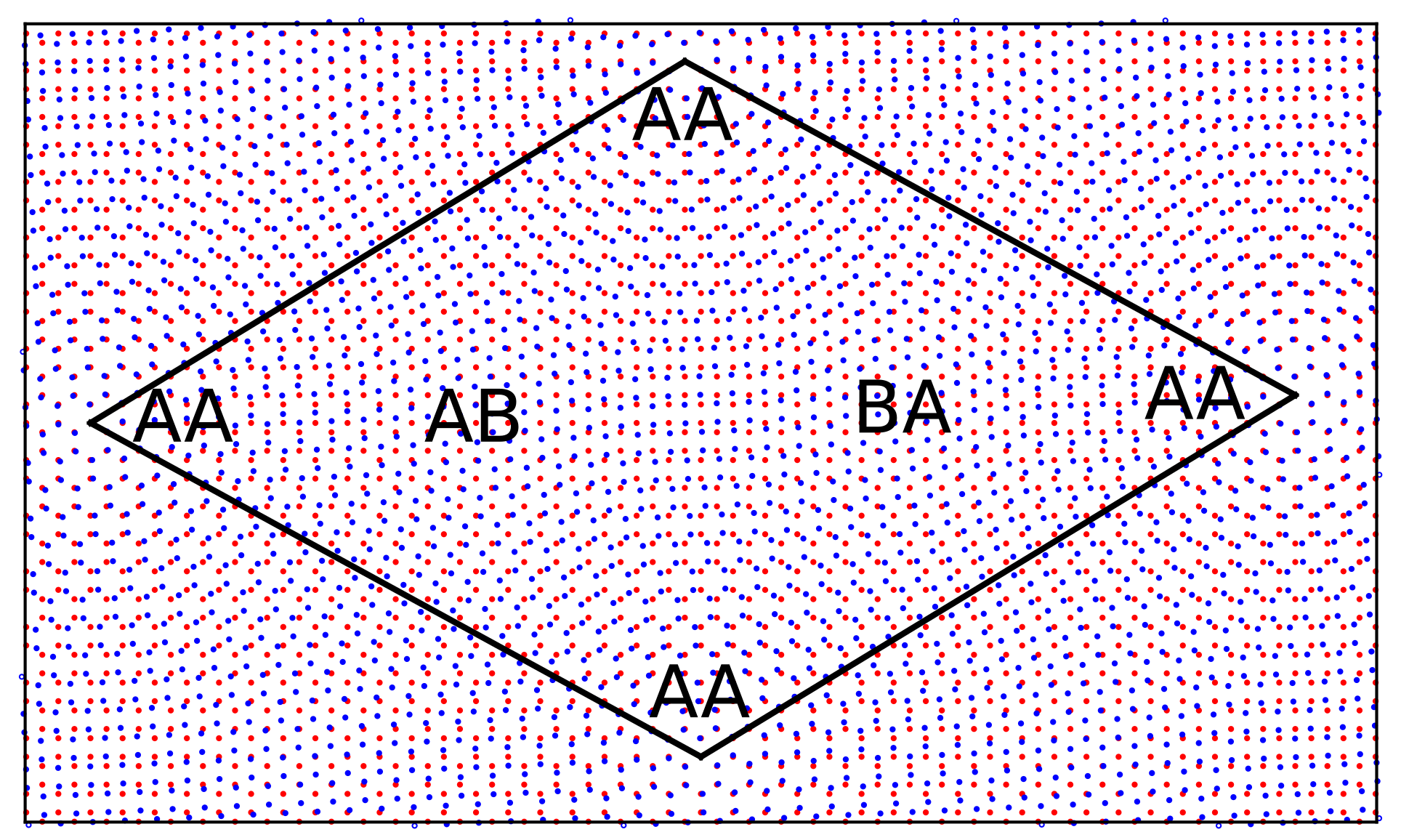 Aficionados of strongly correlated physics were thrilled by the discovery of correlated insulating states and superconductivity in magic-angle twisted bilayer graphene (MA-TBG) in 2018. The phase diagram shows certain similarities with the one of the cuprates but there are many distinct features. Debates continue on an effective model for this system, especially on the nature of the effective interactions and possible external screening effects. We have applied the constrained random phase approximation to study screening effects based on an atomic scale tight-binding model of TBG. This provides an estimate for the dielectric function and the strength of the effective Coulomb interaction entering the low-energy description.
Aficionados of strongly correlated physics were thrilled by the discovery of correlated insulating states and superconductivity in magic-angle twisted bilayer graphene (MA-TBG) in 2018. The phase diagram shows certain similarities with the one of the cuprates but there are many distinct features. Debates continue on an effective model for this system, especially on the nature of the effective interactions and possible external screening effects. We have applied the constrained random phase approximation to study screening effects based on an atomic scale tight-binding model of TBG. This provides an estimate for the dielectric function and the strength of the effective Coulomb interaction entering the low-energy description.
References:
- arXiv:1909.09556

